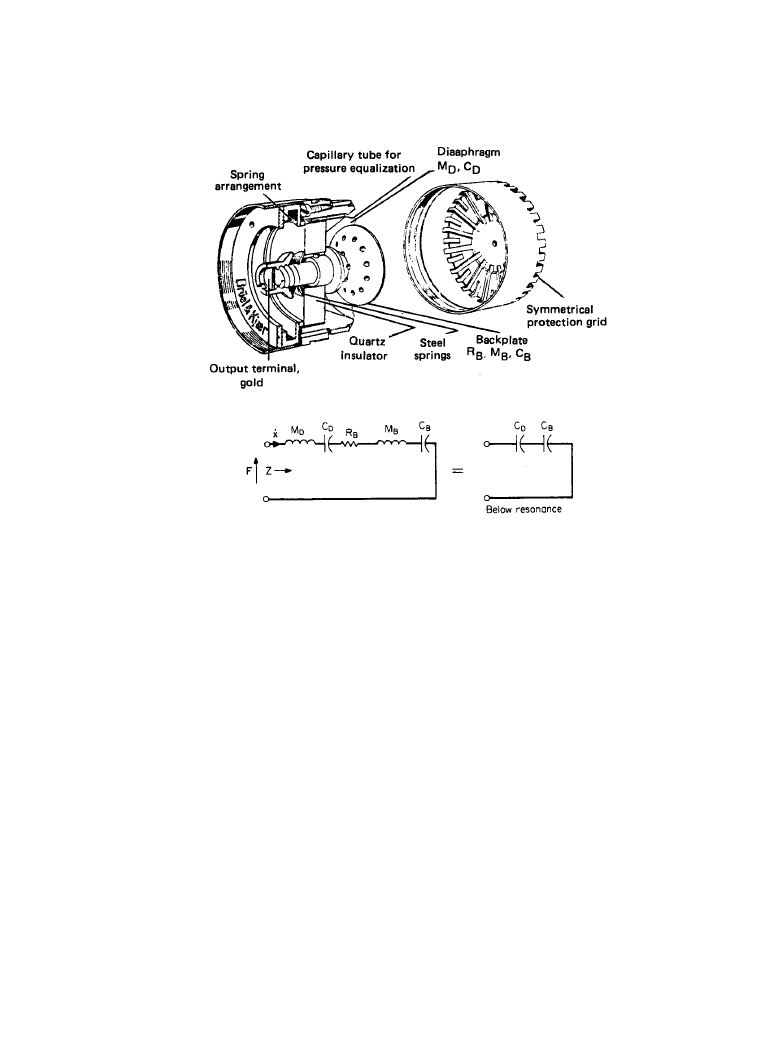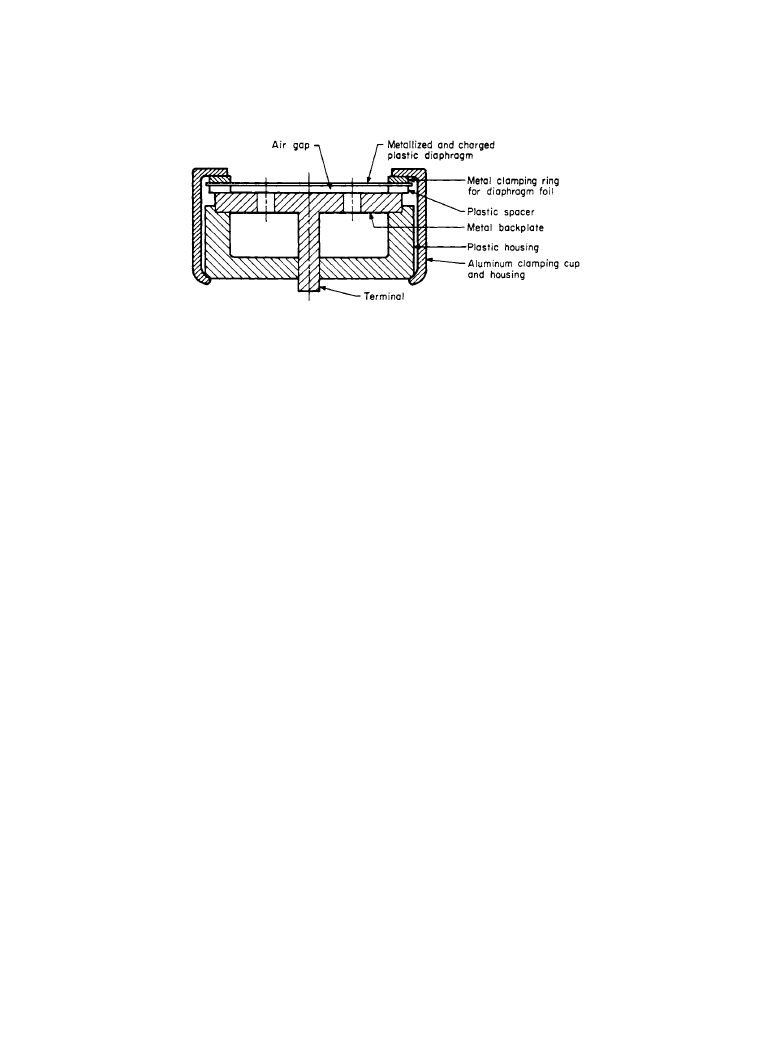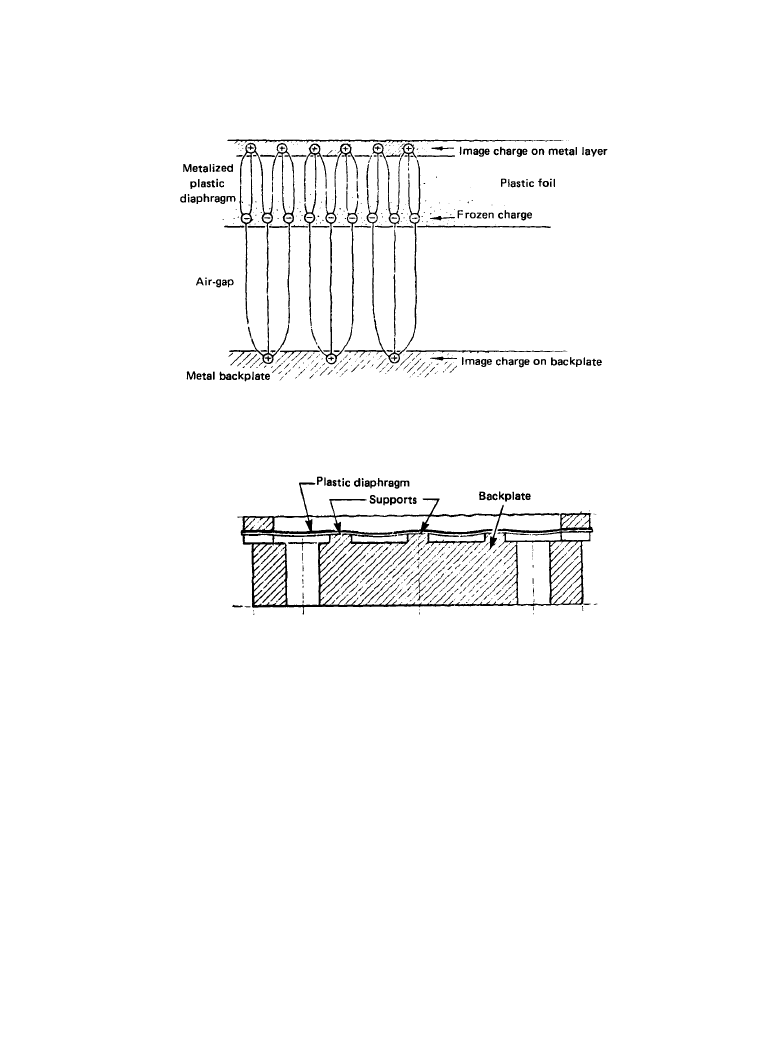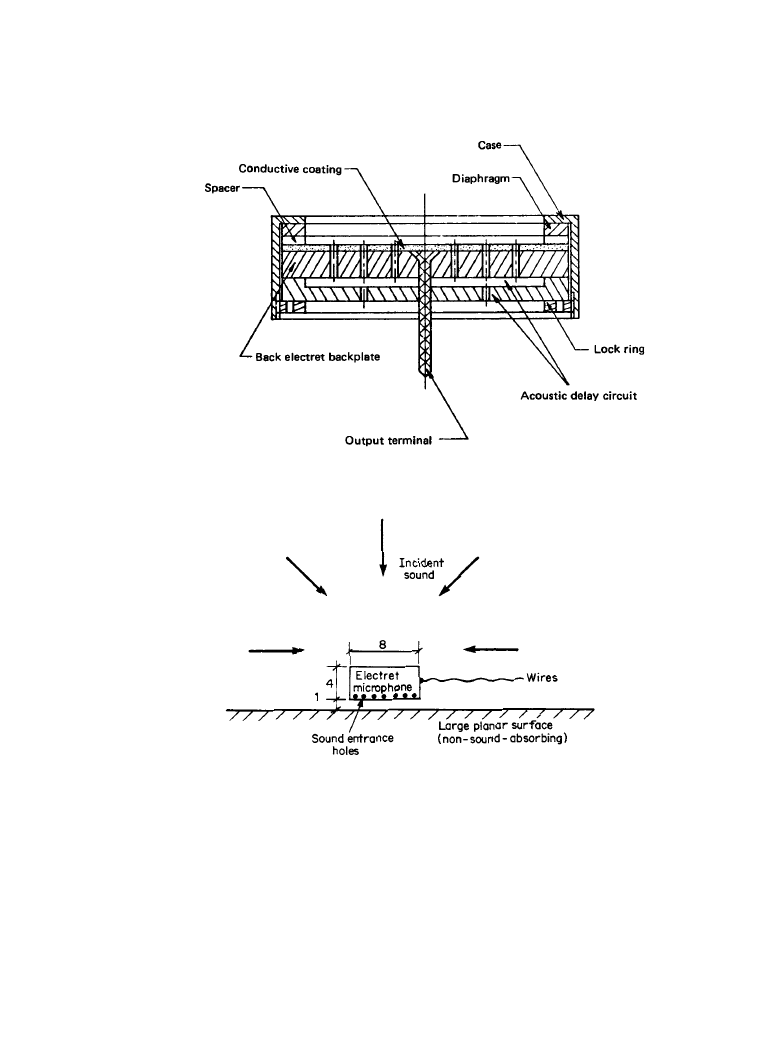ВУЗ: Казахская Национальная Академия Искусств им. Т. Жургенова
Категория: Книга
Дисциплина: Не указана
Добавлен: 03.02.2019
Просмотров: 21632
Скачиваний: 19

4-10 Microphone Devices and Systems
temperature and humidity. The cost is relatively low. Therefore, the ceramic microphone was
widely used with tube-type home tape recorders and low-cost communications equipment. With
the advent of solid-state equipment, low-impedance microphones were needed and the ceramic
microphone has since been replaced by inexpensive moving-coil (dynamic) microphones or elec-
tret condenser microphones, which typically include integral field-effect transistor (FET) pream-
plifiers that convert their output to low impedance.
The piezoelectric diaphragm transducer is a variation on the basic theme. A thick or thin film
of the polymer polyvinylidene fluoride (PVF
2
) may be processed to form a piezoelectric ele-
ment. As with the ceramic element, it must be provided with plated-on output terminals.
4.1.2b
Electrostatic (Condenser) Microphones
A condenser microphone depends for its operation on variations in its internal capacitance. Fig-
ure 4.1.3 shows the capsule of an omni-directional pressure-sensing condenser microphone [3].
Condenser microphones are divided into two classes: externally polarized (air condenser) and
prepolarized (electret condenser). The function of the polarizing voltage or its equivalent is to
translate the diaphragm motion into a linearly related audio output voltage, which is amplified by
a very-high-impedance FET preamplifier, which must be located close to the capsule. Alter-
Figure 4.1.3
Condenser pressure microphone and mechanical network. (
From [3]. Used with per-
mission.)
Downloaded from Digital Engineering Library @ McGraw-Hill (www.digitalengineeringlibrary.com)
Copyright © 2004 The McGraw-Hill Companies. All rights reserved.
Any use is subject to the Terms of Use as given at the website.
Microphones

Microphones 4-11
nately, the capacitance variation can be used to frequency-modulate a radio-frequency (RF)
oscillator.
The diaphragm of this microphone is a thin membrane of nickel that is spaced about 0.001 in
(25
µm) from the backplate. Because the electroacoustical sensitivity is inversely proportional to
the spacing d, special measures must be taken to prevent this distance from changing because of
temperature. The laboratory-grade microphone of Figure 4.1.3 is made almost entirely of nickel
and nickel alloys and has nearly constant sensitivity from 20 to 150° C.
The performance may be determined by consideration of the mechanical network (Figure
4.1.3). The resonance is placed at the high end of the usable frequency range. The backplate air
load includes mass M
B
, compliance C
B
, and resistance R
B
. M
B
and C
B
plus the diaphragm mass
M
D
and compliance D
D
determine the resonance frequency. R
B
provides damping of the reso-
nance. Below the resonance frequency, the microphone is stiffness-controlled (reciprocal of
compliance) and only C
D
and C
B
appear in the circuit. The open-circuit output voltage E is given
by [2] and [4].
(4.1.2)
Where:
E
0
= polarizing voltage (or equivalent voltage for electrets)
d = spacing from diaphragm to backplate, m
x = diaphragm displacement, m
= diaphragm velocity, m/s
ω =2πf
f = frequency, Hz
The velocity is given by
(4.1.3)
Where:
F = force on diaphragm, N
P = sound pressure on diaphragm, N/m
2
A = area of diaphragm, m
2
Z = mechanical impedance system, mechanical ohms
The output voltage is obtained by combining Equations (4.1.2) and (4.1.3).
(4.1.4)
This means that below resonance the response is independent of frequency.
E
E
0
d
------x
=
x
x·
j
ω
----
=
x·
x·
F
Z
---
PA
1/j
ω
(
) 1/C
D
1/C
M
+
(
)
-----------------------------------------------------
=
=
E
E
0
PA
d
1
C
D
-------
1
C
B
-------
+
------------------------------
=
Downloaded from Digital Engineering Library @ McGraw-Hill (www.digitalengineeringlibrary.com)
Copyright © 2004 The McGraw-Hill Companies. All rights reserved.
Any use is subject to the Terms of Use as given at the website.
Microphones

4-12 Microphone Devices and Systems
The polarization field strength for most condenser microphones, independent of the polariza-
tion principle, is on the order of 100,000 V/cm
9
so that the slightest bit of contamination between
diaphragm and backplate will cause impulsive noise due to arcing. Microphones used in corro-
sive environments may develop pinholes in the diaphragm, and the resulting corrosion behind the
diaphragm eventually may short-circuit the transducer. Normally, impulsive noise is caused by
humidity, which can be eliminated by desiccation.
4.1.2c
Electret Microphone
The simplest type of electret microphone is the charged diaphragm type. This is illustrated in
Figure 4.1.4. The spacing between diaphragm and backplate is exaggerated for clarity. Figure
4.1.5 shows a schematic of the foil electret with the electric charge distribution illustrated. The
electret foil is selected as a compromise between good electret properties and good mechanical
properties as a diaphragm. Polymer materials such as polyacrylonitrile, polycarbonate, and some
fluoric resins are examples of suitable plastic films used as electret diaphragms.
There are several methods of making an electret. Typically, one side of the plastic film is
coated by vacuum sputtering a conductive metal such as aluminum, gold, or nickel. The thick-
ness of the coating is about 500 A (50 nm). The film is then heated and charged with a high dc
potential, with the electret-forming electrode facing the nonconductive side of the film [5]. A
well-designed electret capsule will retain its charge and exhibit nearly constant sensitivity for 10
years, and it is predicted that it will take 30 to 100 years before the sensitivity is reduced by 3 dB.
These plastic-foil electrets generally will not stand the tension required to obtain the high res-
onant frequencies commonly employed in externally polarized microphones. One solution is to
reduce tension and support the diaphragm at many points by means of a grooved backplate (Fig-
ure 4.1.6). This and other schemes used to increase stiffness can lead to short-term instability [6].
Therefore, the charged-diaphragm electret generally does not possess the extended high-fre-
quency response and stability of the air-condenser microphone. Its great advantage is that it can
be made very cheaply by automated manufacturing methods.
An improved form of electret transducer is the back electret, or charged back-plate design [7].
Figure 4.1.7 shows a simplified cross section of a typical design. (Dimensions are exaggerated
for clarity. (This is a pressure-gradient microphone, to be discussed later.) The diaphragm is a
Figure 4.1.4
Typical design of an electret capsule with a charged foil diaphragm. (
From [7]. Used
with permission.)
Downloaded from Digital Engineering Library @ McGraw-Hill (www.digitalengineeringlibrary.com)
Copyright © 2004 The McGraw-Hill Companies. All rights reserved.
Any use is subject to the Terms of Use as given at the website.
Microphones

Microphones 4-13
polyester film such as Mylar, approximately 0.0002 in (5
µm) thick. This is an ideal material and
thickness for a diaphragm. The diaphragm is coated on one or both sides with a thick film of
gold or other metal. The electret is made of a fluoric film such as Teflon, which must be at least
0.001 in (25
µm) thick to form a stable electret. This electret is placed on the backplate, which
must have a conducting surface to form the “high” output terminal The electret element is
charged similarly to the charged-diaphragm electret. Since the electret does not function as a dia-
phragm, the material and thickness are chosen as optimal for high sensitivity and stability. The
diaphragm-to-back-plate (electret) spacing is the same as for the air condenser, approximately
0.001 in (25
µm). The equivalent polarization potential is 100 to 200 V, which is the same as that
used in high-quality air-condenser microphones. (Teflon and Mylar are trademarks of E. I. du
Pont de Nemours and Co., Inc.)
Figure 4.1.5
Positions of charges for space-charge electret when the electret is an integral part of
the diaphragm. The frozen charge and the charge on the backplate produce the field in the air that
is necessary for microphone operation. (
From [7]. Used with permission.)
Figure 4.1.6
Principle used by some manufacturers to obtain a sufficiently high resonance fre-
quency of plastic diaphragms having low creep stability. (
From [7]. Used with permission.)
Downloaded from Digital Engineering Library @ McGraw-Hill (www.digitalengineeringlibrary.com)
Copyright © 2004 The McGraw-Hill Companies. All rights reserved.
Any use is subject to the Terms of Use as given at the website.
Microphones

4-14 Microphone Devices and Systems
4.1.2d
Boundary Microphone
The boundary microphone involves a pressure-recording process in which a conventional micro-
phone is placed very close to a plane surface such as a floor [8]. This has given rise to a number
of products which basically function as shown in Figure 4.1.8. A miniature electret microphone
is spaced about 0.04 in (1 mm) from a large reflecting plane. A conventional microphone, which
is situated above the floor, receives the direct sound wave plus a reflected wave from the floor. It
Figure 4.1.7
The back-electret capsule. (
From [5]. Used with permission.)
Figure 4.1.8
Boundary-microphone principle. Dimensions are in millimeters.
Downloaded from Digital Engineering Library @ McGraw-Hill (www.digitalengineeringlibrary.com)
Copyright © 2004 The McGraw-Hill Companies. All rights reserved.
Any use is subject to the Terms of Use as given at the website.
Microphones